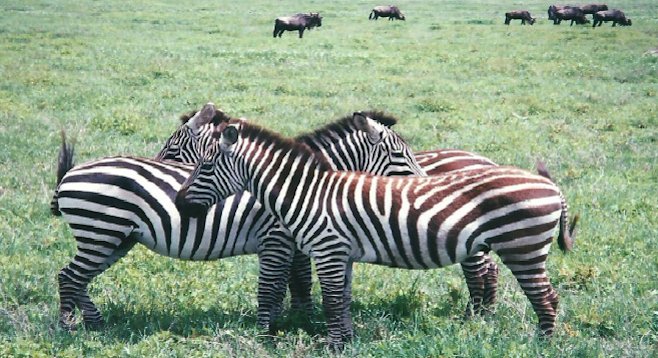 Facebook
Facebook
 X
X
 Instagram
Instagram
 TikTok
TikTok
 Youtube
Youtube

The Ngorongoro Conservation Area (NCA) in Tanzania includes the Ngorongoro Crater, covering 8,300 square kilometers and the only place on earth where mankind and wild animals co-exist in harmony. This uniqueness earned it a UNESCO World Heritage Site designation in 1979; it is the largest intact volcanic caldera in the world.
With high concentrations of wildlife offering close-range viewing, Ngorongoro is one of East Africa’s most visited destinations. Within its walls you are likely to see lions, elephants, buffaloes and flamingos; and there’s a chance of seeing black rhinos. Local Maasai tribes have grazing rights and you may come across them tending their cattle in the midst of wildlife.
You'll notice that the wild animals within the Ngorongoro Crater are accustomed to safari vehicles, so it is easy to view the animals up close. We saw a mother lion with three cubs sleeping undisturbed, and they barely moved when our safari vehicle approached.
The landscape in the crater has it all: salty lakes, fresh water lakes, swamps, rivers, savannah and woodlands. And you see all animals – including lots of lions and other predators such as hyenas fighting for food, with lions in broad daylight. You’ll experience several National Geographic moments during your visit here, including an encounter with all of the “Big 5” game animals.
The area contains over 25,000 large animals, among them 26 black rhinoceros. Wildebeests, zebras and Grant's and Thomson's gazelles number in the thousands. The crater also has the densest known population of lions. In the rainforests of the crater rim are leopards, cape buffalos, spotted hyenas, jackals, rare African wild dogs and elusive cheetahs.
The November and December months are considered the high season with short rains, and the end of February and early March is the best time to see the wildebeest migration, which attracts a large number of predators.
The entrance fee is $25 USD per person per 24-hour period and most people visit the area as part of a longer safari. Entrance hours are limited from 7:00 a.m. to 6:00 p.m.


The Ngorongoro Conservation Area (NCA) in Tanzania includes the Ngorongoro Crater, covering 8,300 square kilometers and the only place on earth where mankind and wild animals co-exist in harmony. This uniqueness earned it a UNESCO World Heritage Site designation in 1979; it is the largest intact volcanic caldera in the world.
With high concentrations of wildlife offering close-range viewing, Ngorongoro is one of East Africa’s most visited destinations. Within its walls you are likely to see lions, elephants, buffaloes and flamingos; and there’s a chance of seeing black rhinos. Local Maasai tribes have grazing rights and you may come across them tending their cattle in the midst of wildlife.
You'll notice that the wild animals within the Ngorongoro Crater are accustomed to safari vehicles, so it is easy to view the animals up close. We saw a mother lion with three cubs sleeping undisturbed, and they barely moved when our safari vehicle approached.
The landscape in the crater has it all: salty lakes, fresh water lakes, swamps, rivers, savannah and woodlands. And you see all animals – including lots of lions and other predators such as hyenas fighting for food, with lions in broad daylight. You’ll experience several National Geographic moments during your visit here, including an encounter with all of the “Big 5” game animals.
The area contains over 25,000 large animals, among them 26 black rhinoceros. Wildebeests, zebras and Grant's and Thomson's gazelles number in the thousands. The crater also has the densest known population of lions. In the rainforests of the crater rim are leopards, cape buffalos, spotted hyenas, jackals, rare African wild dogs and elusive cheetahs.
The November and December months are considered the high season with short rains, and the end of February and early March is the best time to see the wildebeest migration, which attracts a large number of predators.
The entrance fee is $25 USD per person per 24-hour period and most people visit the area as part of a longer safari. Entrance hours are limited from 7:00 a.m. to 6:00 p.m.
Comments